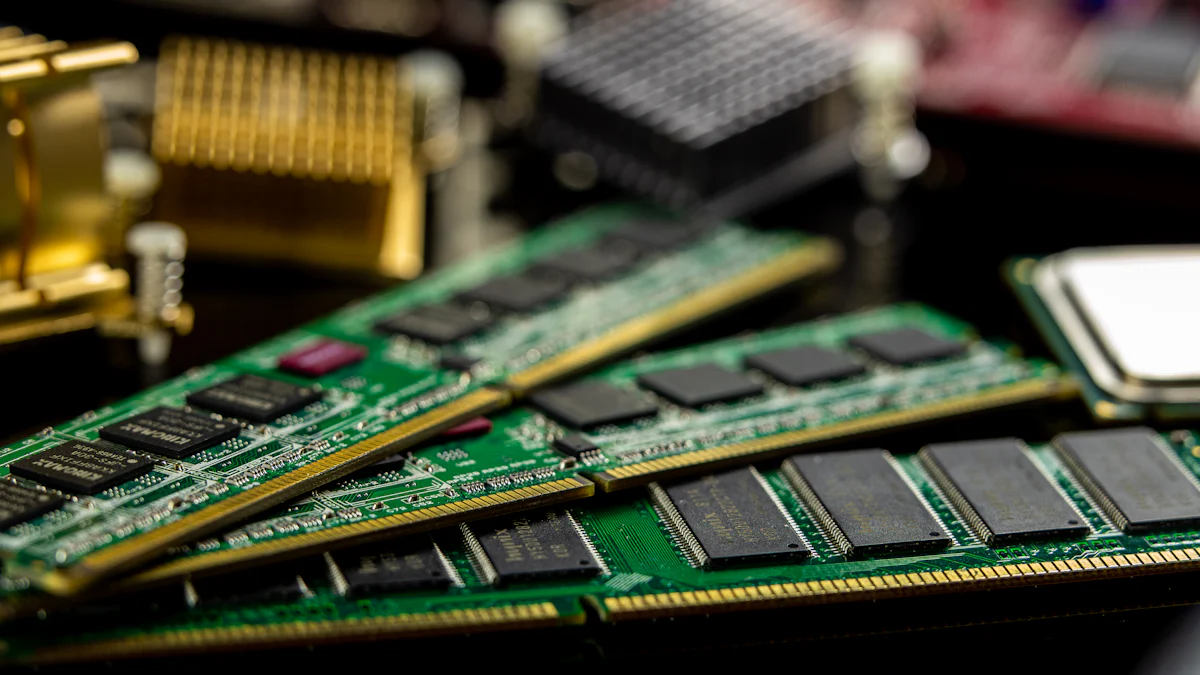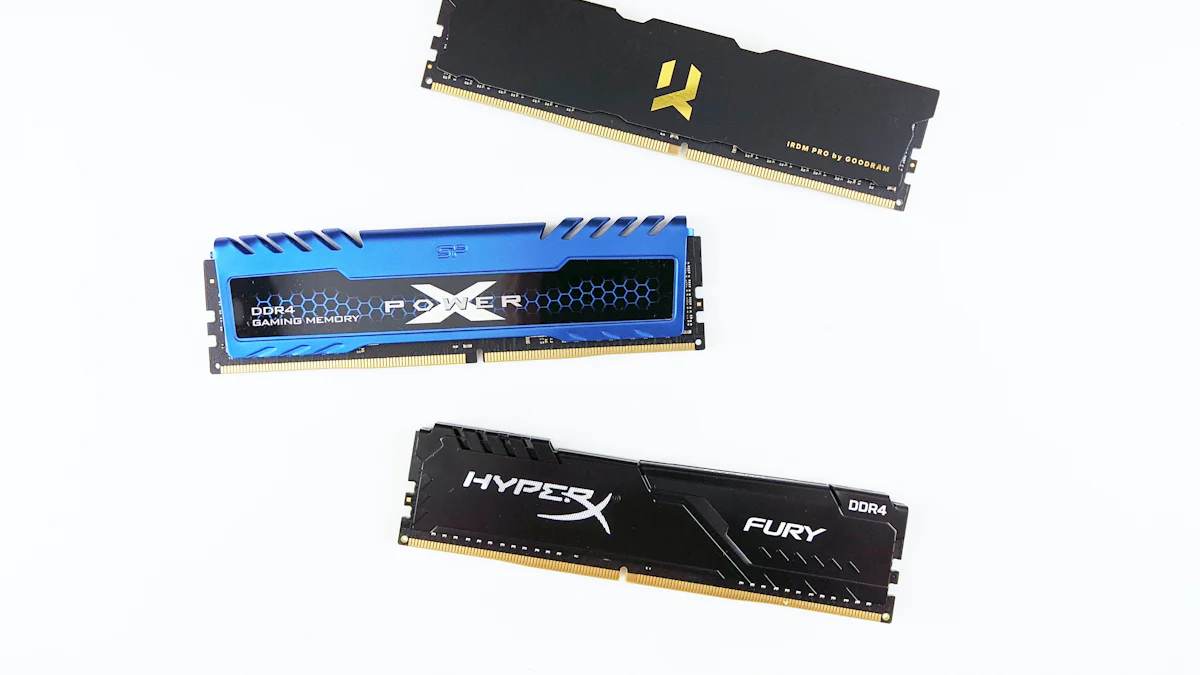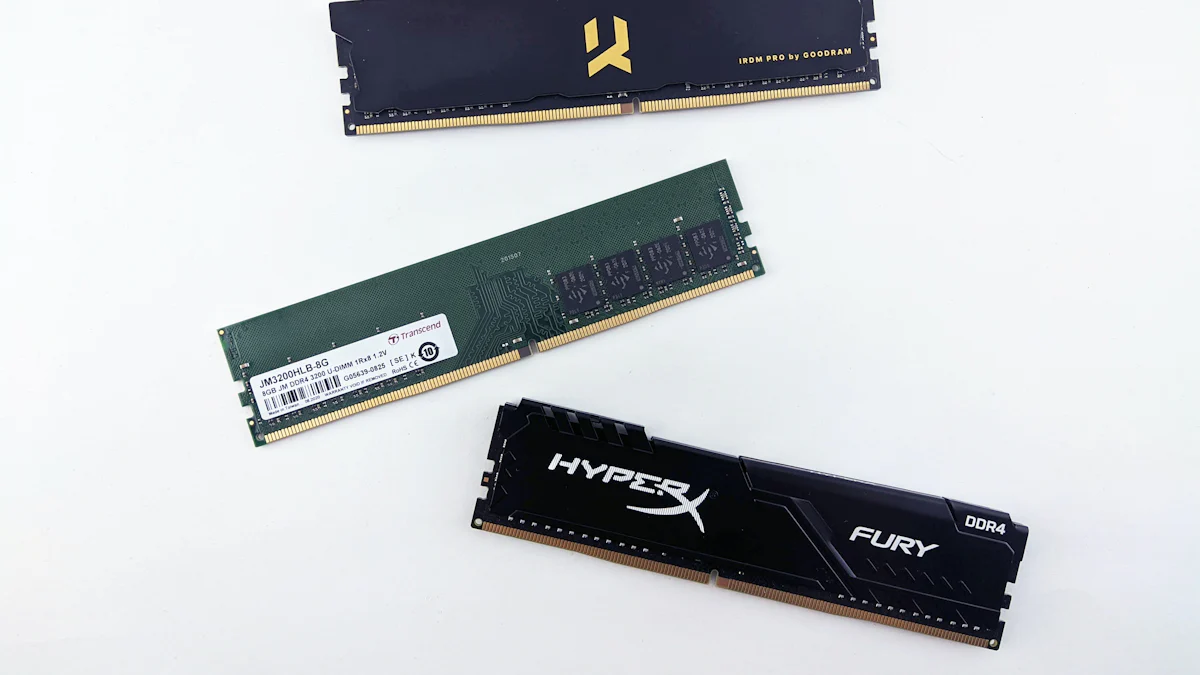DDR5 vs DDR4 RAM Which One is Right for You

Choosing between DDR5 and DDR4 RAM can feel overwhelming, especially with so many factors to consider. If you're after cutting-edge performance, DDR5 might catch your eye. It offers faster speeds and higher capacities, but it comes with a higher price tag. For instance, a 16GB DDR5 kit costs around $70, while a similar DDR4 module is priced under $40. On the other hand, DDR4 remains a solid choice for most users. Its affordability and widespread adoption make it a go-to option for laptops, gaming consoles, and even industrial automation. Whether you're building a gaming rig or upgrading your PC, understanding what is DDR5 vs DDR4 will help you make the right call.
Key Takeaways
DDR5 RAM is faster, starting at 4800 MT/s. DDR4's top speed is 3200 MT/s.
DDR4 RAM is still a good and cheaper choice. It works well for gaming and daily tasks.
DDR5 can hold more memory, from 8GB to 64GB per chip. This makes it great for heavy programs.
DDR5 uses less power at 1.1V, which is 20% lower than DDR4's 1.2V.
If you're on a budget, DDR4 is the better pick. It's cheaper and works with most systems.
Think about your needs: DDR5 is better for future use and tough tasks. DDR4 is fine for simple use.
To use DDR5, you need the right motherboard and CPU. Check your system before upgrading.
DDR5 is improving, but DDR4 will still be useful. It's a good choice for saving money.
What is DDR5 vs DDR4?
Overview of DDR4 RAM
Key Features of DDR4 RAM
DDR4 RAM has been the backbone of modern computing for years. It’s reliable, affordable, and widely supported. You’ll find it in everything from gaming PCs to office desktops. But what makes DDR4 RAM so popular? Let’s break it down:
Speed and Bandwidth: DDR4 offers data transfer rates starting at 2133 MT/s and scaling up to 3200 MT/s. While not as fast as DDR5, it’s still plenty for most tasks.
Power Efficiency: It operates at 1.2V, which is more efficient than older DDR3 modules.
Capacity: DDR4 supports memory modules ranging from 2GB to 16GB per chip, making it versatile for various use cases.
Compatibility: It works with a wide range of CPUs and motherboards, ensuring you won’t face compatibility issues.
Why DDR4 RAM Has Been the Standard for Years
DDR4 RAM became the standard because it struck the perfect balance between performance and cost. Its increased bandwidth and lower power consumption compared to DDR3 made it a no-brainer for manufacturers and users alike. Plus, its widespread adoption means you can easily find DDR4 modules at competitive prices. Whether you’re gaming, editing videos, or just browsing the web, DDR4 RAM delivers dependable performance without breaking the bank.
Overview of DDR5 RAM
Key Features of DDR5 RAM
DDR5 RAM is the new kid on the block, and it’s packed with features that push the boundaries of what RAM can do. Here’s what sets it apart:
Blazing Speed: DDR5 starts at 4800 MT/s, a significant leap from DDR4’s 3200 MT/s. Future modules are expected to hit speeds of 8800 MT/s or more.
Increased Bandwidth: With 50% more bandwidth than DDR4, DDR5 ensures smoother multitasking and faster data transfer rates.
Power Efficiency: It operates at just 1.1V, consuming 20% less power than DDR4. This is especially beneficial for laptops and servers.
Higher Capacity: DDR5 supports memory capacities ranging from 8GB to 64GB per chip, making it ideal for demanding applications.
Advanced Power Management: DDR5 features on-board Power Management Integrated Circuits (PMIC), improving power distribution and signal integrity.
Dual Subchannels: Each module is divided into two 32-bit subchannels, enhancing efficiency and performance.
How DDR5 RAM Improves Upon DDR4
When comparing DDR4 vs DDR5, the improvements are clear. DDR5 RAM offers faster speeds, higher capacity, and better power efficiency. For instance, DDR5’s minimum speed of 4800 MT/s outpaces DDR4’s maximum of 3200 MT/s. It also consumes less power, thanks to its 1.1V operation and integrated PMIC.
Here’s a quick comparison:
Specification | DDR5 | DDR4 |
|---|---|---|
Maximum Speed | 4800 MT/s (initial) | 3200 MT/s |
Power Consumption | 20% less than DDR4 | Standard 1.2V |
Memory Capacity | 8 to 64 GB per chip | 2 to 16 GB per chip |
Bandwidth | 50% more than DDR4 | Lower bandwidth |
PMIC | Integrated for better power management | On-motherboard management |
DDR5 RAM isn’t just about raw performance. Its increased bandwidth and higher capacity make it perfect for future-proofing your system. Whether you’re a gamer, a content creator, or a professional, DDR5 offers a noticeable upgrade over DDR4.
DDR4 vs DDR5: Key Differences

Performance and Bandwidth
Clock Speeds and Bandwidth Comparison
When it comes to performance, DDR5 RAM takes the lead with its greater speed and higher transfer speeds. DDR4 RAM offers a standard speed of 3200 MT/s, while DDR5 starts at 4800 MT/s and can go up to 8000 MT/s. That’s a significant jump! The increased bandwidth in DDR5 is another major difference. DDR4 provides a system bandwidth of 33.6 GB/s, but DDR5 doubles that to 69.2 GB/s.
Here’s a quick comparison:
Specification | DDR4 | DDR5 |
|---|---|---|
Default Clock Speed | 2133 MHz | 4800 MHz |
Maximum Speed | 3200 MT/s | 8000 MT/s |
System Bandwidth | 33.6 GB/s | 69.2 GB/s |
This higher bandwidth means DDR5 can handle more data transfer rates, making it ideal for multitasking and demanding applications.
Real-World Performance Differences
In real-world scenarios, the performance boost from DDR5 depends on the task. For instance, DDR5 shows a 20% improvement in 7-Zip compression and wins in HandBrake video encoding. However, for gaming, the differences are minimal. Games like Counter-Strike: Global Offensive and Valorant show almost identical frame rates with DDR4 and DDR5. So, while DDR5 offers a performance boost in some areas, DDR4 RAM still holds its ground in gaming and everyday tasks.
Power Efficiency
Voltage Requirements of DDR5 vs DDR4
DDR5 RAM is more power-efficient than DDR4 RAM. It operates at 1.1V compared to DDR4’s 1.2V. This lower voltage not only reduces energy consumption but also improves power regulation. For laptops and servers, this efficiency can make a noticeable difference in battery life and operational costs.
Specification | DDR4 | DDR5 |
|---|---|---|
Voltage | 1.2V | 1.1V |
Energy Consumption and Heat Generation
DDR5 consumes about 20% less power than DDR4. This reduction is especially beneficial for enterprise servers that run 24/7. Less power consumption also means less heat generation, which helps maintain system stability and reduces the need for extensive cooling solutions.
Capacity and Scalability
Maximum Module Sizes for DDR5 and DDR4
DDR5 RAM offers a significant upgrade in memory capacity. While DDR4 supports up to 16GB per chip, DDR5 can handle up to 64GB per chip. This increased capacity makes DDR5 a game-changer for users who need to run memory-intensive applications like CAD modeling or video editing.
Benefits of Higher Capacity in DDR5 RAM
The higher capacity in DDR5 RAM translates to better performance in specific applications. For example, games like F1 2021 and Forza Horizon 4 see a 10% FPS improvement, while professional tools like Adobe Photoshop and DaVinci Resolve run 12-17% faster. For tasks like geographical surveys or medical imaging, DDR5 delivers a 24-33% performance boost. If you’re a content creator or a professional, DDR5’s higher capacity can save you time and improve productivity.
Latency
Understanding Latency in DDR4 vs DDR5
When comparing DDR4 vs DDR5, latency is one of the key factors to consider. Latency refers to the time it takes for your RAM to respond to a request from the CPU. While DDR5 RAM offers higher speeds and bandwidth, its latency is slightly higher than DDR4 RAM. For example, DDR5-4800 with a CAS latency of 40 (CL40) has a system latency of 92.8 nanoseconds (ns). In contrast, DDR4-3200 with a CAS latency of 22 (CL22) achieves a slightly lower system latency of 90.0 ns.
Memory Specification | System Latency |
|---|---|
DDR5-4800 CL40 | 92.8 ns |
DDR4-3200 CL22 | 90.0 ns |
This difference in latency is minimal—just about 3%. For most users, it’s barely noticeable in real-world applications. DDR5 compensates for this with its higher bandwidth and improved multitasking capabilities. So, unless you’re working on latency-sensitive tasks, this shouldn’t be a dealbreaker.
How Latency Impacts Performance
Latency can affect performance, but its impact depends on what you’re doing. For gaming, the slight increase in DDR5’s latency doesn’t make much of a difference. Frame rates in popular games like Valorant or Fortnite remain nearly identical whether you’re using DDR4 or DDR5. However, for tasks like video editing or 3D rendering, DDR5’s higher bandwidth and memory capacity often outweigh its slightly higher latency. In short, while latency matters, DDR5’s overall performance boost makes it a better choice for demanding workloads.
Price-to-Performance Ratio
Current Market Prices of DDR5 and DDR4
The price of DDR5 RAM has dropped significantly since its launch. Today, you can find DDR5 RAM for around $3 per gigabyte. A 16GB DDR5 kit costs under $50, making it more affordable than ever. On the other hand, DDR4 RAM remains a budget-friendly option. A decent 16GB DDR4 kit at 3200MHz costs around $40-50. If you’re looking for higher capacities, a 32GB dual-channel DDR5 kit at 5600MHz is priced between $100-120. While DDR5 is still more expensive than DDR4, the gap is narrowing.
Value for Money in Different Scenarios
When it comes to the price-to-performance ratio, DDR4 RAM still offers better cost-effectiveness for most users. For example, a DDR4-3200 kit priced at $85 performs well across various benchmarks, making it a great choice for gaming or general use. However, DDR5 RAM shines in specific scenarios. A DDR5-6000 kit priced at $118 delivers impressive results in professional workloads. For instance, it costs just $0.59 per second for tasks like Adobe Photoshop and $0.20 per second for compiling code in Mozilla.
RAM Type | Price | Performance Metric | Cost per Second |
|---|---|---|---|
DDR5 6000 | $118 | Mozilla Compile | $0.20 |
DDR5 6000 | $118 | Adobe Photoshop | $0.59 |
DDR4 3200 | $85 | Various Benchmarks | Better cost-effectiveness |
If you’re building a budget gaming rig or upgrading an older system, DDR4 RAM offers excellent value. But if you’re a content creator or professional, DDR5 RAM’s performance boost and future-proofing make it worth the investment.
Use-Case Scenarios: DDR5 RAM vs DDR4 RAM

Gaming
Performance Gains in Gaming with DDR5 RAM
If you're a gamer, you're probably wondering if DDR5 RAM will give you a noticeable edge. The truth is, the performance boost depends on the game. For instance:
In Counter-Strike: Global Offensive, DDR4 averaged 832 FPS, while DDR5 hit 828 FPS.
Valorant showed DDR4 at 486 FPS compared to DDR5's 445 FPS.
Far Cry 6 had DDR4 at 143 FPS, slightly ahead of DDR5's 139 FPS.
Doom Eternal saw DDR5 barely outperform DDR4, with 393 FPS versus 392 FPS.
Overall, DDR5 offers a 7-15% improvement in frame rates for some games, which translates to smoother gameplay. However, for most titles, the difference is minimal. If you're playing competitive games, DDR5 might not drastically change your experience. But for future games that demand more from your system, DDR5 could be a smart choice.
Is DDR4 RAM Still Good Enough for Gamers?
Absolutely! DDR4 RAM remains a fantastic option for gaming in 2024. It delivers reliable speed, low latency, and compatibility with most gaming systems. You can enjoy smooth gameplay and quick load times, especially with higher-speed DDR4 modules. Plus, DDR4 is more affordable, making it a cost-effective upgrade for budget-conscious gamers.
DDR4 is great for budget builds.
It’s sufficient for average users and most gamers.
If you're not chasing the latest tech, DDR4 still provides excellent value for gaming.
Productivity and Professional Workloads
Benefits of DDR5 RAM for Content Creation
For content creators and professionals, DDR5 RAM is a game-changer. It doubles the system bandwidth compared to DDR4, which means faster performance for memory-intensive tasks. Whether you're editing videos, working on 3D models, or analyzing big data, DDR5 helps you get the job done more efficiently.
High-capacity DDR5 modules handle demanding applications like video editing and CAD modeling with ease.
Enhanced multitasking lets you run multiple heavyweight programs without slowing down.
If your work involves data-heavy applications, DDR5's performance boost can save you time and improve productivity.
When DDR4 RAM Is Sufficient for Productivity
Not every professional needs DDR5. If your tasks involve basic productivity, like word processing or light photo editing, DDR4 RAM is more than enough. It offers dependable performance at a lower price. For small businesses or casual creators, DDR4 provides a solid balance of cost and capability. Unless your workload demands cutting-edge performance, DDR4 will serve you well.
Budget Builds
Cost Considerations for DDR4 RAM
DDR4 RAM is the go-to choice for budget builds. It’s affordable, widely available, and compatible with most systems. A 16GB DDR4 kit costs around $40-50, making it a great option if you're trying to save money. You can build a capable gaming or productivity PC without overspending. DDR4 offers a fantastic price-to-performance ratio, especially for users who don’t need the latest features.
Is DDR5 RAM Worth the Investment for Budget Users?
If you're building on a budget, DDR5 RAM might seem like a stretch. However, it could be worth the investment if you're looking to future-proof your system. DDR5 is becoming more affordable, with prices dropping to around $3 per gigabyte. If you plan to upgrade your motherboard and memory, DDR5 could be a smart long-term choice. But if saving money is your top priority, DDR4 remains the better option for now.
Future-Proofing
Longevity of DDR5 RAM
If you're thinking about future-proofing your system, DDR5 RAM is the clear winner. It’s designed to handle the demands of tomorrow’s technology. Here’s why DDR5 stands out:
It supports up to 64GB per chip, compared to DDR4’s 16GB limit. This means you can run more memory-intensive applications without breaking a sweat.
DDR5 offers at least 50% more bandwidth than DDR4, ensuring smoother multitasking and faster data transfers.
It operates at a lower voltage of 1.1v, reducing power consumption and heat generation.
DDR5 also introduces some exciting new features. Each module has two channels, which improves memory efficiency. Its new power architecture enhances signal integrity, making your system more stable. Plus, DDR5’s longer burst length allows for increased concurrency, meaning it can handle more tasks at once.
If you’re building a high-performance PC or planning to keep your system for years, DDR5 is a smart investment. It’s built to support the next generation of gaming, productivity, and professional workloads. While it might cost more upfront, its advanced features and scalability offer excellent value in the long run.
How Long DDR4 RAM Will Remain Relevant
You might wonder if DDR4 is still worth considering. The answer is yes—at least for now. DDR4 RAM remains widely used across various industries and devices. Its affordability and compatibility make it a practical choice for many users.
The market for DDR4 isn’t going anywhere anytime soon. It’s supported by a vast range of CPUs and motherboards, and its infrastructure is deeply embedded in the tech world. Even as DDR5 gains traction, DDR4 will continue to serve gamers, budget builders, and casual users effectively.
For gaming, DDR4 still delivers reliable performance. Most current games don’t fully utilize DDR5’s capabilities, so you won’t miss out on much by sticking with DDR4. If you’re on a tight budget or upgrading an older system, DDR4 offers great value without compromising too much on speed or efficiency.
However, keep in mind that DDR4’s relevance will gradually decline as DDR5 becomes the new standard. If you’re planning a long-term upgrade, it might be worth considering DDR5 to stay ahead of the curve. But for now, DDR4 remains a dependable and cost-effective option for most users.
Compatibility Considerations for DDR5 and DDR4
Motherboard and CPU Support
Which CPUs Support DDR5 RAM?
Before diving into DDR5, you need to check if your CPU supports it. Not all processors are compatible with DDR5 RAM. Currently, Intel’s 12th Gen Alder Lake and newer CPUs, along with AMD’s Ryzen 7000 series, support DDR5. These processors are designed to take full advantage of DDR5’s higher speeds and bandwidth. If you’re using an older CPU, you’ll likely need to stick with DDR4 unless you’re planning a full system upgrade.
Backward Compatibility with DDR4 RAM
Here’s the catch: DDR5 and DDR4 are not interchangeable. They have different physical designs, so you can’t use DDR5 RAM in a DDR4 motherboard or vice versa. Some motherboards, like Intel’s Z690 series, offer dual compatibility, but you’ll need to choose one type of RAM when building your system. If you’re upgrading, make sure your motherboard supports the RAM type you plan to use.
Upgrading from DDR4 to DDR5
What You Need to Know Before Upgrading
Switching from DDR4 to DDR5 isn’t as simple as swapping out your RAM sticks. You’ll need a compatible motherboard and CPU to make the leap. DDR5 offers several advantages over DDR4, including higher speeds, greater bandwidth, and improved power efficiency.
Here’s a quick comparison to help you decide:
Specification | DDR5 | DDR4 |
|---|---|---|
System Bandwidth | 33.6 GB/s | |
Voltage | 1.1V | 1.2V |
Speed | 5600 MT/s | 3200 MT/s |
DDR5 consumes about 20% less power than DDR4, which is a big deal for servers and systems running 24/7. Its built-in Power Management Integrated Circuits (PMICs) also improve power regulation, making it more efficient overall. If you’re a gamer or professional, DDR5’s faster data transfer rates and higher capacity can significantly enhance performance in demanding applications.
Is It Worth Upgrading Now or Waiting?
Deciding whether to upgrade to DDR5 now or wait depends on your needs and budget. DDR5 offers noticeable performance improvements, especially for multitasking and memory-intensive tasks. It’s faster and more efficient, which means smoother performance for games and programs.
However, there are a few things to consider:
DDR5 is still more expensive than DDR4, so it might not fit every budget.
Not all motherboards support DDR5, so you may need to replace your motherboard and CPU.
DDR4 remains a solid option for most users, especially for gaming and everyday tasks.
If you’re building a new system or planning to keep your PC for years, DDR5 is a smart choice for future-proofing. But if you’re on a tight budget or don’t need cutting-edge performance, sticking with DDR4 for now makes sense. As DDR5 becomes more mainstream, prices will continue to drop, making it even more accessible in the future.
Choosing between DDR5 and DDR4 RAM boils down to your priorities. DDR5 shines with its superior performance, offering up to 2x the bandwidth of DDR4. It’s perfect for multitasking, video editing, or 3D animation. Plus, it consumes 20% less power, making it efficient for high-end systems.
Feature | DDR5 | DDR4 |
|---|---|---|
Starting Data Rate | 3200MT/s | |
Power Consumption | ~20% less | N/A |
Bandwidth Increase | 50% increase | N/A |
However, DDR4 remains a reliable, cost-effective choice for gaming or budget builds. Think about your needs. Do you want cutting-edge speed or value for money? Your decision should reflect your goals and future plans.
FAQ
What is the main difference between DDR4 and DDR5 RAM?
DDR5 offers faster speeds, higher bandwidth, and better power efficiency compared to DDR4. It’s designed for future-proofing and demanding tasks, while DDR4 remains a reliable and affordable option for most users.
Can I use DDR5 RAM in a DDR4 motherboard?
No, DDR5 and DDR4 are not physically compatible. They have different pin layouts and require specific motherboards. Check your motherboard’s specifications before purchasing RAM.
Is DDR5 worth the extra cost for gaming?
It depends on your needs. For most games, DDR4 performs just as well as DDR5. However, DDR5 can future-proof your system and handle upcoming, more demanding games better.
How much RAM do I need for gaming or productivity?
For gaming, 16GB is usually enough. If you’re into video editing, 3D modeling, or multitasking, 32GB or more is ideal. DDR5’s higher capacity per module can be a game-changer for professionals.
Will DDR4 RAM become obsolete soon?
Not anytime soon! DDR4 is still widely used and supported. It’s a great choice for budget builds and gaming. However, DDR5 will gradually become the standard as technology advances.
Does DDR5 RAM consume less power than DDR4?
Yes, DDR5 operates at 1.1V, compared to DDR4’s 1.2V. This makes DDR5 about 20% more power-efficient, which is especially beneficial for laptops and servers.
Should I upgrade to DDR5 now or wait?
If you’re building a new system or need cutting-edge performance, go for DDR5. Otherwise, DDR4 is still a solid choice. Waiting could save you money as DDR5 prices continue to drop.
What CPUs support DDR5 RAM?
Intel’s 12th Gen Alder Lake and newer CPUs, along with AMD Ryzen 7000 series, support DDR5. Make sure your CPU and motherboard are compatible before upgrading.
See Also
Speed and Performance Comparison Between eMMC and SSD
Essential Differences Between CR1620 and CR2032 Batteries
Understanding Voltage Regulator Modules and Their Key Factors
